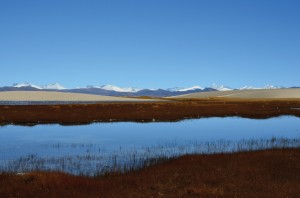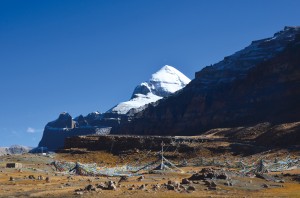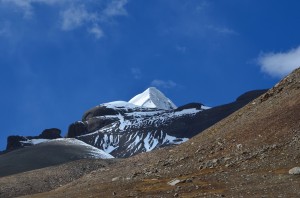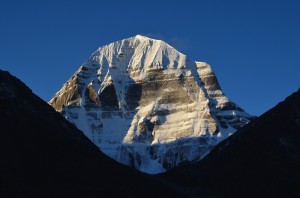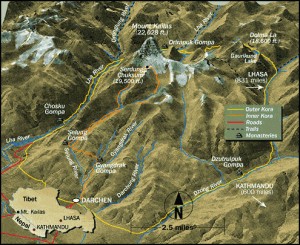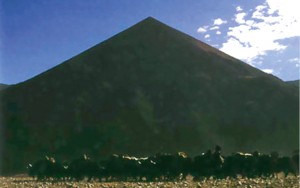KAILASH (Tibet, China)
2.2 Power place
Names
The word construction “Hima” and “Alaya” originates from Sanskrit and means residence of the snow. And the sacred mountain has many names:
Hinduism/Sanskrit
– Kailash, Kailasa, Kailasah, Kailas, Kailasi
Buddhism
– Meru, Sumeru (navel of the world)
– Kang Rinpoche (snow jewel)
Bön
– (Kang) Tise (soul mountain of the white snow
– Yundrung Gutseg, Gut Seg (nine overlapping swastikas)
Jainism
– Ashtapada (octopod)
– Mandara (twirling stick)
Geomancy
An impressive mountain landscape with vast plateaus at around 4,500 m, between the mountain ranges of the Himalayas in the south and the Transhimalayas in the north, with their majestic peaks of 6,000 to 8,000 m.
Between them, huge lakes and river deltas which help the steppe grass grow even at this altitude to feed the many yaks and sheep.
It is cold and barren, but also clear, cleansing, invigorating and elevating here, where earth meets the heavens. For me, this was the purest and clearest place after Taklamakan and the Galapagos.
Power point
Mount Kailash itself, or rather its pyramid-shaped peak, is the place of power. And the energy there is truly wonderfully pure and uplifting.
It is the best-known and most sacred mountain in Asia. It, and the neighboring Lake Manasarovar, are pilgrimage destinations for millions of people, because for about four thousand years this mountain has been a mystical center, making it probably the oldest pilgrimage site on Earth.
And Mount Kailash is regarded as the most important spiritual site and center of the universe for four religions: Buddhism, Hinduism, Jainism and Bön.
In the cosmologies and original myths of Hinduism, Jainism and Buddhism, Mount Kailash is seen as the mythical mountain Meru, Axis Mundis, center and birthplace of the entire universe. Deeply embedded in the myths of ancient Asia, Mount Kailash is to many the place with the strongest cosmic energies.
– Corresponds to the forehead chakra, reason
– Color indigo/dark blue
– Dominant elements of earth and air
– Corresponding place: Tiwanaku, Bolivia
2.3 Main structures
So far, no megalithic complexes have been found around Mount Kailash, although they are mentioned in Tibetan legends “inside the sacred mountain”.
The White Pyramid
Old legends speak of a large pyramid near Kailash, which is found beneath the ice and is only accessible a few days each year when the snow recedes to the greatest extent in the seasonal cycle. I am convinced that it truly does exist, because the Atlanteans built a pyramid in each of the 7/14 power points. When I was there in October 2013, my guide questioned many Sherpas and elderly people. Most of them said that the pyramid can be found hidden beneath the snow at the peak of Kailash, while others that it is the pyramid on the stone plateau to the left of the pyramidal peak (fig. 2.10). Neither of these theories can be proved, because any climbing of the holy mountain is prohibited. One Sherpa was convinced that is it the pyramid-shape grotto buried in a permanent layer of snow near Purang on the border to Nepal, around 120 from Kailash, which bears the hand and footprints of their ancestors (see page 152).
Around 170 km southwest from Lhasa, around 1,200 away from the Kailash, lays the mysterious Yarlung Valley. According to old sources among the Lamas, the Tibetan civilization arose and the Yarlung Canyon, with its deep gorges, is also considered to be a potential location for the legendary Shangri-La (see page 148). In his book “Serpent of Light”, Drunvalo and in the YouTube video „The Great White Pyramid of Tibet and the Flower of Life“, Drunvalo describes a „white pyramid“ in Tibet. This Nakkal Pyramid, named after an ancient Nakkal Brotherhood, should lie in the Yarlung Valley, the rather wide main valley, which is relatively well accessible. He obtained this information from a team that was there twice after taking six months to find the pyramid. It is the largest pyramid in the world, around 13,000 years old, and also does not bear any inscriptions, like the great pyramids in Giza. It contains stairs and a large room with a „Flower of Life“ on the ceiling. That would be a wondrous discovery, which would also confirm the Atlantean theory; unfortunately no photos or details about the location and dimensions have been published. The photo of this Nakkal Pyramid making the rounds on the Internet is quite dark and is usually called the „Pyramid of Gathering“. However, it has been proven not to be a manmade pyramid beneath the snow, but a subsequently geometrically shaped mountain peak like the Kailash (see the comparison of the Photoshopped image and the old black and white original). According to Chamba, my Tibetan guide, who is well familiar of all the regions in Tibet and who very frequently undertakes expeditions in the Yarlung Mountains, there is no real pyramid to be found there. He also conducted further research with three Tibetan Sherpas who life in Yarlung and Nedong, but none of them ever heard of this pyramid either.
This is just a small excerpt from the book GAIA LEGACY.
2. Mount KAILASH (Tibet)
2.1 Landscape 139
– Geography 139
– Geology 139
– Vegetation 144
– Climate 145
2.2 Place of power 146
– Names 146
– Geomancy 146
– Power point 146
2.3 Structures 147
– Main structures 147
– Underground complexes 148
– Temple structures 148
– Other structures in the region 148
2.4 History 151
– Historical History 151
– Finds 152
– Prehistoric history 154
– Builders and peoples 154
– Original purpose 155
– Legends and myths 157
2.5 Spirit 160
– Religions and deities 160
– Spirituality and transmissions 168

